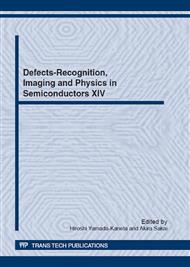p.15
p.19
p.23
p.27
p.31
p.35
p.41
p.45
p.49
Frank Partial Dislocation in 4H-SiC Epitaxial Layer by MSE Method
Abstract:
We have been trying to improve a quality of crystal, using the metastable solvent epitaxy (MSE) method, one of the solution methods. In MSE, a Frank-type fault is formed by conversion of a threading screw dislocation (TSD) in the substrate. To study the status of the growth, we performed plane-viewed TEM observation. Analysis of Burgers vectors in the TEM image showed Frank PDs (Partial Dislocations) which do not include a components and Frank PDs which include a components. The total Burgers vectors of Frank-type fault including a components are represented as b=a/3+c, which indicates some TSDs in the substrate also include a components.
Info:
Periodical:
Pages:
31-34
Citation:
Online since:
July 2012
Keywords:
Price:
Сopyright:
© 2012 Trans Tech Publications Ltd. All Rights Reserved
Share:
Citation:


